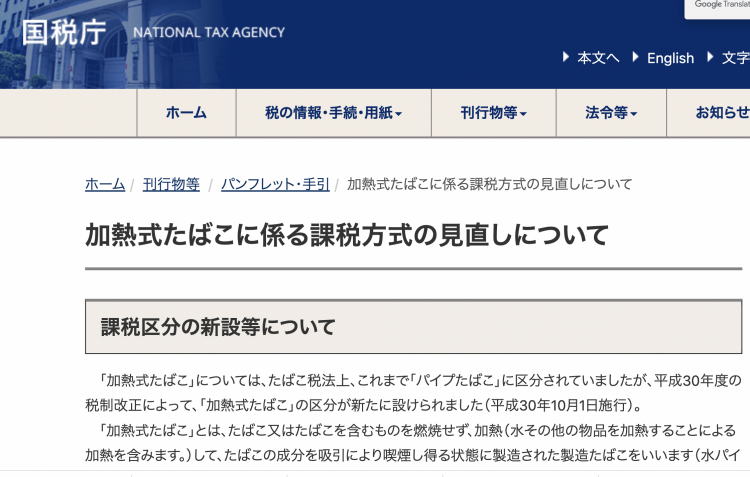
Three major heat-not-burn tobacco companies in Japan have recently adjusted their retail prices for tobacco products. On August 16th of this year, PMI Japan, a subsidiary of Philip Morris International, was the first to apply to the Ministry of Finance for a price increase for their heat-not-burn tobacco products. On the 25th, Japan Tobacco (JT) applied for a price increase of 20 to 30 yen per pack across 41 brands. The following day, BAT Japan also applied for a price increase. All three companies have now applied for price increases.
In two months' time, on October 1, 2022, Phillip Morris Japan (PMJ) for its "IQOS" series and Japan Tobacco (JT) for its "Ploom" series announced their plans to adjust the retail price of their products. British-American Tobacco Japan (BAT) for its "glo" series, meanwhile, also plans to adjust its retail prices, but this will happen on November 1, 2022. Under Japan's Tobacco Business Act, tobacco manufacturers must apply for approval from the Minister of Finance before modifying the retail prices of their products.
In addition, both companies are seeking approval to modify their retail prices, with some brands remaining unchanged. For instance, JT's product Mevius Plume Tech Current will be adjusted from 570 yen to 600 yen per box, while Mevius Plume Tech Plus will go from 580 yen to 600 yen.
Behind the collective announcement of tobacco merchants raising prices, aside from maintaining company profits, the root cause stems from the increase in the heating tobacco tax. Little known is the fact that Japan's heating tobacco tax adjustment took four years and underwent five revisions, with the massive undertaking only being completed in October of this year.
Origin: Rapid Market Expansion Triggers Reassessment of Tax System.
Due to the rapid expansion of the market for tobacco products that are heated but not burned in recent years, coupled with the inadequate regulation system, a new tax category needs to be established in the Japanese market for such products. The tax system must also be reevaluated based on the unique characteristics of these products.
Subsequently, the Japanese government initiated research and discussions on tax reform. Finally, in 2017, a plan to gradually increase the tax on "heat-not-burn" tobacco was approved by the chairman of the Liberal Democratic Party's tax research committee, Yoichi Miyazawa. The Liberal Democratic Party proposed a phased increase in tax rates from the fiscal year 2018 to the fiscal year 2022, raising it to around 70-90% of the tax on regular cigarettes. After coordination with the Komeito party, the plan was included in the tax reform outline of the ruling coalition on the 14th day.
Taking into account the impact of taxes on businesses and consumers, the Japanese Ministry of Finance and National Tax Agency have decided to implement a gradual taxation system for the heated tobacco tax. Starting from October 1st, 2018, this tax rate will be implemented in five phases for a period of five years, during which a periodic review of the tax system will be conducted. This year marks the final stage of the tax increase, with a planned increase of 10 to 20 yen per pack for heated tobacco products in Japan.
Process: Complicated Tax Calculation Methods.
During the four-year transition period, cigarette taxes also increased. In 2018, 2020, and 2021, the Japanese National Tax Agency increased the cigarette tax by 1 yen per cigarette (20 yen per pack). In 2022, the National Tax Agency did not increase the cigarette tax but instead increased the heated tobacco tax. The so-called transitional phase of the heated tobacco tax is also linked to the cigarette tax.
According to the official website of Japan's Ministry of Finance, before the tax system reform on October 1, 2018, "heated tobacco products" were classified under the taxable category of "tobacco leaves," with the weight of one gram of product being equivalent to one cigarette. As heated tobacco products weigh relatively less per cigarette, the tax percentage in the price was lower.
After the tax reform, "heated tobacco products" have become a new type of tax, and the method of tax calculation is quite complicated. How much should a pack of taxable HNB tobacco weigh? According to the official website of the Japanese National Tax Agency, it should first be converted into "cigarette units", and then calculated according to relevant formulas. Specifically, based on weight and retail price, the following formula is used to convert it into cigarette units (see chart below).
For example, in 2018, the tax rate conversion formula for non-combustible heated tobacco products included the weight of one pack (including paper rolls, filters, etc.) multiplied by 0.8, the weight of the tobacco in one pack (excluding paper rolls and filters) divided by 0.4g multiplied by 0.5 and 0.2, and the retail price of one pack of non-combustible heated tobacco products divided by the average retail price of one pack of cigarettes multiplied by 0.5 and 0.2. Over the course of five years, the percentage calculated according to Note 2 decreases by one-fifth each year, while the percentage calculated according to Note 3 increases by one-fifth each year. After four years, the tax rate conversion is complete.
Due to the complexity of the conversion method, when converting heated tobacco to cigarettes, the National Tax Administration website also requests that the "Heated Tobacco Easy Conversion Table" be attached to facilitate business completion of the conversion.
Endgame: How will the market react to the final tax hike?
According to a report from the Yomiuri Shimbun, the Japan Franchise Association announced on the 21st that the national sales of convenience stores in October (based on existing stores) reached 930.7 billion yen, a year-on-year increase of 6.9%. Due to the rebound from the suppressed purchases caused by the tobacco tax increase last October, "non-food" saw a significant growth of 13.7%. The average amount spent per customer was 712.2 yen, an increase of 5.7%. Thus, from the performance of this single month, it appears that Japanese consumers of heated tobacco products are not highly sensitive to prices.
After undergoing four years of adjustments, whether or not Japan will make further changes to its heating tobacco tax in the next fiscal year has become a highly-watched issue.
According to a report from the Advisory Committee, the Japanese government is preparing to comprehensively adjust its defense spending and fiscal resources. This will be done alongside the revision of the Mid-Term Defense Plan, which will take place at the end of the year with the National Security Strategy, as well as the drafting of the 2023 fiscal year budget and taxation reform. Additionally, the Japanese government has established a spending and revenue framework for the next five years, and a fourth consumption tax increase is being considered, specifically for tobacco and financial income, in addition to the basic corporate and income taxes.
In other words, the Japanese government is placing increasing importance on the health of its citizens.
Article by Song Yutong
2FIRSTS will continue to track and report on this topic, with further updates available on the '2FIRSTS APP.' Scan the QR code below to download the app.
Statement:
1. This article is intended solely for internal industry communication and discussion, and is not meant for any brand or product promotion or recommendation. 2. Smoking is harmful to health. Minors are prohibited from reading this article.
This article is an original piece from 2FIRSTS Technology Co., Ltd. of Shenzhen, and the copyright and license to use it belong to the company. Any institutions or individuals who are not authorized are not allowed to reproduce, reprint or use it in any other way to infringe upon the company's copyright. The company reserves the right to pursue legal responsibility against any violators.
This document has been generated through artificial intelligence translation and is provided solely for the purposes of industry discourse and learning. Please note that the intellectual property rights of the content belong to the original media source or author. Owing to certain limitations in the translation process, there may be discrepancies between the translated text and the original content. We recommend referring to the original source for complete accuracy. In case of any inaccuracies, we invite you to reach out to us with corrections. If you believe any content has infringed upon your rights, please contact us immediately for its removal.






